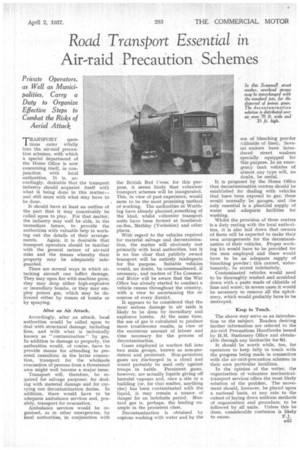Road Transport Essential in,
Page 57

If you've noticed an error in this article please click here to report it so we can fix it.
Air-raid Precaution Schemes
Private Operators, as Well as Municipalities, Carry a Duty to Organize Effective Steps to Combat the Risks of
Aerial Attack
TRANSPORT ques1 lions enter vitally into the air-raid precaution schemes, with which a special department of the Home Office is now concerning itself, in conjunction with local authorities. It is, accordingly, desirable that the transport industry should acquaint itself with what is being done in this matter— and still more with what may have to be done.
It should have at least an outline of the part that it may conceivably be called upon to play. For that matter, the industry may well be able, in the immediate future, to provide the authorities with valuable help in working out the details of their arrange ments. Again, it is desirable that transport operators should be familiar with the general nature of air-raid risks and the means whereby their property may be adequately safe:• guarded.
There are several ways in which attacking aircraft can inflict damage. They may open fire with machine guns; they may drop either high-explosive or incendiary bombs, or they may employ poison gas, which may be delivered either by means of bombs or by spraying, After an Air Attack.
Accordingly, after an attack, local authorities would be called upon to deal with structural damage, including fires, and with what is technically known as "contamination" by gas. In addition to damage to property, the authorities would, of course, have to provide means for attending to personal casualties; in the latter connection, transport for the wholesale evacuation of persons from a threatened area might well become a major issue.
Transport will, therefore, be required for salvage purposes; for dealing with material damage and for carrying out decontamination duties. In addition, there would have to be adequate ambulance services and, possibly, transport for evacuation.
Ambulance services would be organized, as in other emergencies, by local authorities, in conjunction with the British Red Cross; for this purpose, it seems likely that volunteer transport schemes will be inaugurated. This, in view of past experience, would seem to be the most promising method of working. The authorities at Worthing have already planned,something of the kind, whilst volunteer transport units have been formed at Southendon-Sea, Methley (Yorkshire) and other places.
With regard to the vehicles required for material salvage and decontamination, the matter will obviously rest primarily with local authorities, but it is no less clear that publicly owned transport will be entirely inadequate for the purpose. Suitable vehicles would, no doubt, be commandeered, if necessary, and readers of The Conttnerial Motor Will be aware that the War Office has already started to conduct a vehicle census throughout the country, with a view to ascertaining the resources of every district.
It appears to be considered that the most serious damage in air raids is likely to be done by incendiary and explosive bombs. At the same time, the use of gas is calculated to produce more troublesome results, in view of the enormous amount of labour and time necessary for the process of decontamination.
Gases employed in warfare fall into two main groups, known as non-persistent and persistent. Non-persistent gases are discharged in a cloud and would probably be used only against troops in battle. Persistent gases, however, are actually liquids giving off harmful vapours and, once a site or a building (or, for that matter, anything else) has been contaminated with the liquid, it may remain a source of danger for an indefinite period. Mustard gas is, perhaps, the leading example in the persistent class.
Decontamination is obtained by copious washing with water and by the use of bleaching powder (chloride of lime). Several makers have introduced street washers specially equipped for this purpose. In an emergency tank vehicles of almost any type will, no doubt, be useful.
It is proposed by the Home Office that decontamination centres should be established for dealing with vehicles that have been exposed to gas; these would normally be garages, and the only essential is a plentiful supply, of water and adequate facilities for washing.
Whilst the provision of these centres is a duty resting with the local authorities, it is also laid down that owners of fleets will be expected to Make their own arrangements for the decontamination of their vehicles. Proper working kit would have to be provided for the men employed and there would have to be an adequate supply of bleaching powder : this cannot, unfortunately, be stored indefinitely.
Contaminated vehicles would need to be thoroughly washed and scrubbed down with a paste made of chloride of lime and water; in severe cases it would be necessary to remove all the upholstery, which would probably have to be destroyed.
Keep in Touch.
The above may serve as an introduotion to the subject. Readers desiring further information are referred to the Air-raid Precautions Handbooks issued by H.M. Stationery Office and obtainable through any bookseller for 6d.
It should be worth while, too, for operators to keep fully in touch with the progress being made in connection with the air-raid-precaution schemes in their own particular localities.
In the opinion of the writer, the organization of volunteer mechanicaltransport services offers the most likely solution of the problem. The movement should, however, be placed upon a national basis, at any rate to the extent of laying down uniform methods of organization and procedure, to be followed by all units, Unless this be done, considerable confusion is likely
to ensue. F.J.




























































































